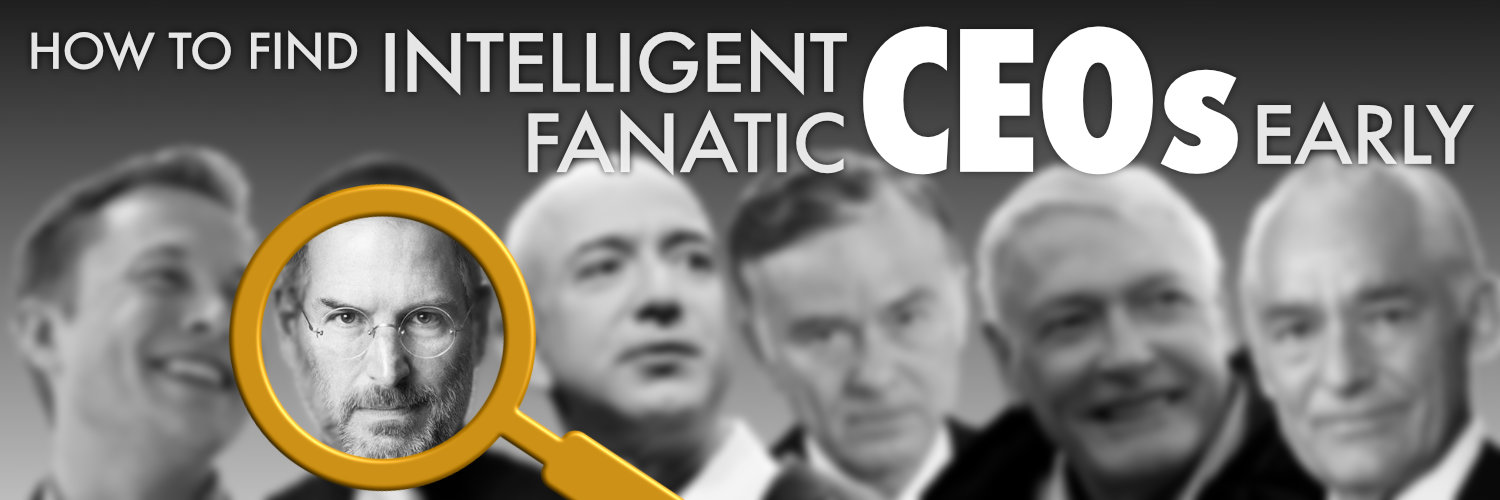
Shelf Life
My intention is to hold stocks forever, but the harsh reality is every stock has different shelf life.
If you want to find great companies early, you need to find great leaders early.

Wal-Mart, Nike, Amazon.com, Starbucks, Ford, Oracle, Microsoft, Facebook, Celgene, Amgen, and others are considered great companies. It is human nature to look at a long-term chart of these companies and think, “well that was easy”, but we all know that isn’t true. Whether it’s business, sports, art, performance, greatness always looks easy because the populace only sees the final result, not the hard work behind the scenes. All great companies faced what looked like insurmountable challenges when they started.
[blockquote cite=”Charlie Munger”]”It’s quite interesting to think about Wal-Mart starting from a single store in Bentonville, Arkansas against Sears, Roebuck with its name, reputation and all of its billions. How does a guy in Bentonville, Arkansas with no money blow right by Sears, Roebuck? And he does it in his own lifetime—in fact, during his own late lifetime because he was already pretty old (44) by the time he started out with one little store….”[/blockquote]
How/Why did Wal-Mart succeed?
The answer is Sam Walton. If you had the ability to invest in Wal-Mart in the 1960’s when it had a few stores, you weren’t betting on Wal-Mart, you were betting on Sam Walton. Even after Wal-Mart had grown to a hundred stores, $200+ million revenues [$1.2 billion – 2015 inflation adjusted], Sam Walton was still flying around in his little airplane finding and negotiating store locations.
For the most part, microcap companies are small, young companies, with short operating histories. Successful microcap investing is similar to successful venture capital investing in that both are bets on founders (on people). Shane Pharrish, founder of Farnam Street, recently interviewed Chris Dixon. Chris Dixon is a partner at one of the most famous venture capital firms in the world, Andreessen Horowitz.
[blockquote cite=”Chris Dixon” type=”center”]“I would say my biggest learning is it’s probably more people than I ever thought…I probably thought originally it was 70% people and now I think it’s 98% people” [/blockquote]
Many investors roll their eyes at the qualitative aspects of investing, but when investing in small microcaps, people (Founders) are the difference makers. In the past there were times where I invested in microcap companies in spite of management. In most cases the company/stock would do well in the short-term, but in the long-term it was like gravity, the business followed the management back down.
The smaller the company the more important the CEO-founder becomes. Often times CEO-founders of microcap companies wear many hats so their influence is multiplied. Not only are they the CEO but also the COO, VP Sales, Garbage Man, Company Contact person, etc. Bad decisions can destroy a small company and great decisions have a compounding effect on a small company. If you don’t believe that founders and management are important to small companies like microcaps, just wait a little longer. You will.
My goal is to own the smallest, most illiquid, least institutionally owned, best businesses I can find that are run by intelligent fanatics. All great companies started as small companies, and intelligent fanatics founded most great companies. Charlie Munger first coined the term “Intelligent Fanatic” but Sanjay Bakshi is the one making it famous today. In Sanjay’s lecture, Seven Intelligent Fanatics From India, he identifies three essential ingredients: Integrity, Energy, and Intelligence. In a recent presentation, I spoke about investing in companies who are run by Intelligent Fanatic Iconoclasts. I’d like to first define “Intelligent Fanatic”:
Intelligent Fanatic = (Long Term Vision + Focus + Energy + Integrity + Intelligence) x Execution
The combination of all these traits multiplied by execution is what makes an intelligent fanatic. Many investors mistake an executive with charisma for being an intelligent fanatic. This isn’t the case, and in fact, many intelligent fanatics are not charismatic. The microcap space in particular is filled with snake oil salesman and executives that talk too much and do too little. Don’t mistake a story telling, charismatic CEO as an intelligent fanatic. Intelligent fanatics let their execution do the talking. Sean Iddings and I are teaming up on the Intelligent Fanatics Project which will highlight several intelligent fanatics and how they built sustainable businesses.
How do we find intelligent fanatics early? How can we find the next Sam Walton, Elon Musk, or Howard Schultz? It’s great to read about them after they’ve made other investors billions, but we want to find them early in their careers. How can we find Reed Hastings 13 years ago when he was leading an $80 million market cap microcap called Netflix (NFLX)?
[blockquote cite=”Max Lucado” type=”center”]“A man who wants to lead the orchestra must turn his back on the crowd.”[/blockquote]
If you want to find intelligent fanatics early, look for intelligent iconoclasm.
Iconoclast: a person who attacks cherished beliefs or institutions.
I’ve found the best resource describing these behaviors in William Thorndike’s great book, The Outsiders: Eight Unconventional CEO’s and Their Radically Rational Blueprint for Success. There is a wealth of information and wisdom in the passage below:
This group of happily married, middle-aged men (and one woman) led seemingly unexciting, balanced, quietly philanthropic lives, yet in their business lives they were neither conventional nor complacent. They were positive deviants, and they were deeply iconoclastic. The word iconoclast is derived from Greek and means “smasher of icons.” The word has evolved to have the more general meaning of someone who is determinedly different, proudly eccentric. The original iconoclasts came from outside the societies (and temples) where icons resided; they were challengers of societal norms and conventions, and they were much feared in ancient Greece….. Like Singleton, these Outsider CEOs consistently made very different decisions than their peers did. They were not, however, blindly contrarian. Theirs was an intelligent iconoclasm informed by careful analysis and often expressed in unusual financial metrics that were distinctly different from industry or Wall Street conventions.
They seemed to operate in a parallel universe, one defined by devotion to a shared set of principles, a worldview, which gave them citizenship in a tiny intellectual village. Call it Singletonville, a very select group of men and women who understood, among other things, that:
- Capital allocation is a CEO’s most important job.
- What counts in the long run is the increase in per share value, not overall growth or size.
- Cash flow, not reported earnings, is what determines longterm value.
- Decentralized organizations release entrepreneurial energy and keep both costs and “rancor” down.
- Independent thinking is essential to long-term success, and interactions with outside advisers (Wall Street, the press, etc.) can be distracting and time-consuming.
- Sometimes the best investment opportunity is your own stock.
- With acquisitions, patience is a virtue . . . as is occasional boldness.
Interestingly, their iconoclasm was reinforced in many cases by geography. For the most part, their operations were located in cities like Denver, Omaha, Los Angeles, Alexandria, Washington, and St. Louis, removed from the financial epicenter of the Boston/New York corridor. This distance helped insulate them from the din of Wall Street conventional wisdom. (The two CEOs who had offices in the Northeast shared this predilection for nondescript locations—Dick Smith’s office was located in the rear of a suburban shopping mall; Tom Murphy’s was in a former midtown Manhattan residence sixty blocks from Wall Street.) The residents of Singletonville, our outsider CEOs, also shared an interesting set of personal characteristics: They were generally frugal (often legendarily so) and humble, analytical, and understated. They were devoted to their families, often leaving the office early to attend school events. They did not typically relish the outward-facing part of the CEO role. They did not give chamber of commerce speeches, and they did not attend Davos. They rarely appeared on the covers of business publications and did not write books of management advice. They were not cheerleaders or marketers or backslappers, and they did not exude charisma.
Most intelligent fanatics are owner-operators that own significant pieces of their businesses. They have their net worth on the line so every decision is made for long-term business reasons. They treat their shares like gold. They normally take below average salaries because they expect to get rich off the stock, not the salary. Elon Musk made $165 million when Paypal was sold to Ebay in 2002. Over the next six years he put his entire net worth into Tesla, SpaceX, and SolarCity, owning substantial pieces of these businesses. He also paid himself California State minimum wage as he was going “all in”. This is an extreme example, but this is what shareholders want to see. I can’t overstate the importance of management-board ownership, compensation, and incentives. Many microcap management teams own meaningful positions in their companies but their compensation and incentives reinforce the wrong things. I also find that most microcap CEO’s view their board of directors as a waste of time. Intelligent fanatics don’t waste time. They create powerful boards that are filled with individuals that create positive feedback loops for the business. They are what Warren Buffett calls an “owners board” where each board member owns a meaningful amount of stock that they paid for with their own money.
[blockquote cite=”Warren Buffett” type=”center”]“At Berkshire, almost everyone on the board has a lot of Berkshire stock. They’re in the same position as shareholders. They don’t have D&O [Directors and Officers] insurance and they bought the stock in the open market. It’s a real owners board.”[/blockquote]
Intelligent fanatic iconoclasts distance themselves physically and mentally from Wall Street. Most hold a disdain for publicity and talking up their stock. They mostly view convincing the prospective investor of the investing merits of their company a waste of time and resources. They are communicative to shareholders but never to the detriment of the business. Be cautious of any CEO that talks about his/her stock price before mentioning the business. They are focused on the wrong thing. Ed Borgato said it best:

Intelligent fanatic iconoclasts Focus On The Long-Term. In the interview below, William Thorndike (@28:20), talks about how Outsider CEO’s optimize long-term value per share (3-5 years) and when the Owner-Operator owns a substantial piece of the company, like Jeff Bezos, they can look out even further because they can afford to not give time-attention to short term influencers. Due to this long-term focus you rarely hear intelligent fanatics talk in short time frames, and they don’t give guidance.
[x_video_embed][/x_video_embed]
[blockquote cite=”Jeff Bezos” type=”center”]“If we have a good quarter it’s because of work we did 3, 4, 5 years ago. It’s not because we did a good job this quarter.”[/blockquote]
William Thorndike (@33:35) also talks about how to find the next Outsider CEO and that the markers are mostly qualitative. He says to look at Vocabulary, how the CEO talks and writes about their business. You want a CEO that discusses “Per Share” metrics, focus on free cash flow not net income, and they get extra credit for using “internal rates of return”. In addition, I would add that intelligent fanatics act and communicate with integrity. It’s not only the business decisions they make during good and bad times that define them but also when they make the right decisions when they don’t have to. Their decision to continue to take a below average salary even though they deserve an above average one. It’s their decision to talk openly about the headwinds affecting the business as well as the tailwinds.
[blockquote cite=”Lou Brock” type=”center”]“Show me a guy who’s afraid to look bad, and I’ll show you a guy you can beat every time.”[/blockquote]
Many intelligent fanatic founder-CEO’s didn’t have previous industry experience. They weren’t taught what was impossible. Their minds weren’t fenced in by conventional norms. They were iconoclasts that intelligently attacked convention. They rose to dominance by trying new things, experimenting, taking calculated risks, and not giving in to the fear of failure. Intelligent fanatics aren’t afraid to shoot a lot of calculated bullets, and when a bullet hits a target they recalibrate and shoot a cannon ball. They don’t dwell on failures.
As Thorndike points out, many intelligent fanatic iconoclasts run businesses with decentralized organizations. Strong leadership and corporate culture are imperative to to the success of decentralized organizations. Leadership and culture is driven from the top down in a way that influences employee devotion and buy-in.
Intelligent fanatic iconoclasts know they can’t be everywhere at once. They know what they don’t know, and they fill those gaps with talented people. This is one big issue I see with many microcap companies. The sheer will power of the founder-CEO can make up for talent gaps, but vigor and energy can only take them so far. Many microcap founders don’t have the awareness and humility to realize when their organizations have outgrown them. Intelligent fanatics hire talented people from the very beginning and focus on creating leaders so they can promote from within.
[blockquote cite=”Tom Peters” type=”center”]“Leaders don’t create more followers, they create more leaders.”[/blockquote]
It is human nature to look for companies attacking huge markets, but most great companies started by dominating a smaller niche. Even Sam Walton of Wal-Mart started by attacking the local merchant in rural towns.
[blockquote cite=”Charlie Munger”]“Walton, being as shrewd as he was, basically broke other small town merchants in the early days. With his more efficient system, he might not have been able to tackle some titan head-on at the time. But with his better system, he could destroy those small town merchants. And he went around doing it time after time after time. Then, as he got bigger, he started destroying the big boys.”[/blockquote]
Most investors look for “big stories” with “big addressable markets”, but in many ways to find the next Wal-Mart you need to think smaller. Intelligent Fanatics dominate small markets first. After they become a big fish in a small pond they look for larger ponds to dominate. The great thing about microcap investing is you can make a lot of money on small companies that can become larger small companies. I’m somewhat oversimplifying but if you can find an undiscovered $5 million revenue profitable business that can grow to $50 million in a reasonable time period without diluting you, this alone will result in 10-20-30+ baggers.
Intelligent fanatics are great capital allocators. They know when/where to reinvest into the business, when to use their stock as currency, and when to buy their stock back. The perfect example of this is Henry Singleton of Teledyne. In the 1960’s, Henry Singleton made 130 accretive acquisitions when his stock was expensive (>25 PE), and in the 1970s and 1980’s bought 90% of Teledyne’s stock back when it was cheap (<8 PE). AutoZone is another modern day example which I tweeted about [HERE].
In conclusion, if you want to find intelligent fanatic CEOs early, a good starting point is finding a company whose founder-CEO owns a significant piece of a good business. It might not be a great business just yet. Second, look for intelligent iconoclasm. In many regards, intelligent fanatics build companies that positively reinforce their iconoclastic behavior. Their business performance and ownership positions allow them security from short-term influences. Intelligent fanatics aren’t distracted by raising money and catering to Wall Street because they create compounding machines. A majority of the best performing microcap stocks ever were profitable growth companies that could self-fund their growth which allowed the intelligent fanatic to focus on execution and capital allocation. This introversion and obsession with the business often creates regrettable personalities. The businesses they create allow them to give Wall Street, the analyst community, and short-term investors the cold shoulder. Why? Because they can. They don’t need them, and it’s exactly what makes intelligent fanatic iconoclast CEOs and their businesses so attractive for long-term investment.
If you liked this article, read this one: All Great Companies Started As Small Companies
===> Interact and learn with 250+ of the best microcap investors on the planet. [Join Us]
MicroCapClub is an exclusive forum for experienced microcap investors focused on microcap companies (sub $500m market cap) trading on United States, Canadian, European, and Australian markets. MicroCapClub was created to be a platform for experienced microcap investors to share and discuss stock ideas. Since 2011, our members have profiled 1000+ microcap companies. Investors can join our community by applying to become a member or subscribing to gain instant view only access. MicroCapClub’s mission is to foster the highest quality microcap investor Community, produce Educational content for investors, and promote better Leadership in the microcap arena. For more information, visit http://microcapclub.com and https://microcapclub.com/summit/
Get Alerted to our Next Educational Blog Post

My intention is to hold stocks forever, but the harsh reality is every stock has different shelf life.

How does a business get a premium valuation when they sell a commodity?

It's often how you react (or don't) to the same situations that shows you how much you’ve grown.